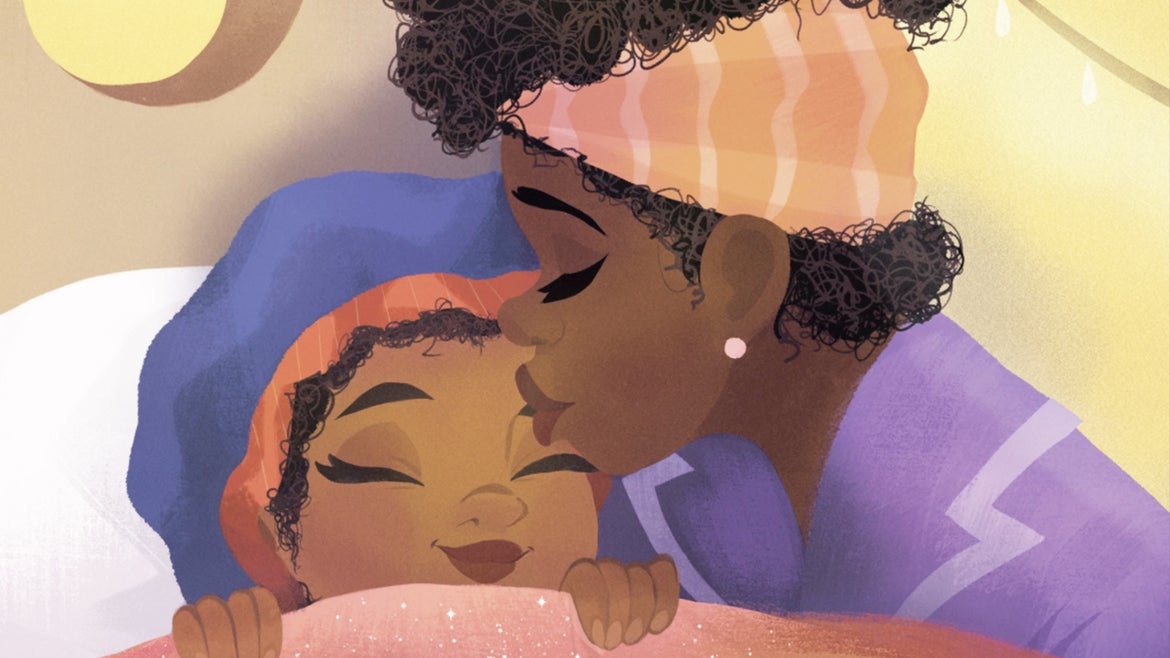Author Nancy Redd said she wrote her first children's book "Bedtime Bonnet" for her daughter, who didn't want to wear a bonnet because she never saw her favorite characters from the books she loved to read wearing one.
There was a time that 6-year-old Nancy Bhattacharya hated wearing her bonnet. She never saw her favorite characters from the books she loved to read wearing one, so despite having textured hair that would be damaged by a normal pillow case, she didn’t think it was for her.
“Because she’d never seen anybody besides me and her grandma wearing a bonnet, she presumed bonnets were just for old people,” her mom, Nancy Redd, told Inside Edition Digital. “Whenever you see a [Black] female cartoon character laying down at night, her hair was never protected by bonnet, which most people who actually live a Black experience know, that is inaccurate assessment of how we sleep.”
Realizing she could create the positive influence she wished her daughter could see in the world, and inspired by her own love of haircare, Redd wrote a children’s book called “Bedtime Bonnet,” that show different ways Black people of all ages take care of their hair.
“She loves it so much. She goes to bed every night with her bonnet on and there are no complaints,” Redd said, adding that other parents have told her that thanks to her book, their kids are wearing their bonnets happily too.
Nearly all experts advocate for diversity in children’s books, and while the University of Wisconsin-Madison School of Education Cooperative Children’s Book Center found in a 2019 study that almost 12% of children’s books were about Black or African American kids, reflective of the number of Black or African American people in the United States, less than half of those books were actually by Black or African American authors.
And by comparison, around 29% of children's books were about animals or “other.”
“Learning about [different peoples’ cultures] only enriches a person’s perspective,” Redd said. “Children are the perfect age, because they're sponges. What they learn between the ages of four and 10 shapes their whole humanity. It's important that we give them as many tools as possible, to not only love their own culture, but to love everyone's culture and have respect for everyone and all aspects of it. “
She continued, “And it's up to us to share our culture, and to have the opportunities to present Black Culture in a light that we are happy with.”
Redd is not alone in her beliefs. In fact, there are plenty of new organizations that have formed with the mission of rectifying the problem.
Nonprofit We Need Diverse Books supports children’s access to different books every step of the way, from mentoring writers or illustrators, supporting books to publication and supplying classrooms with diverse books.
Redd, who has worked with the nonprofit before, said the organization has helped her navigate the “ivory tower situation” that the world of getting published can sometimes be.
“They’ve been so supportive and wonderful,” she said. “They basically dissolve the barriers of class and hierarchy that tends to keep amazing creators from book publishers.”
Chicago-based nonprofit Young, Black & Lit are not only collecting books that feature Black main characters, but also distributing them to schools, students, families and teachers for free.
Founders Krenice Roseman and her husband said it was important for them to not only track down books that were reflective of the communities they serve, but to also provide them the books, citing research that suggested more than 60% of low-income homes do not have books available for their children.
"That speaks to a lack of libraries, a lack of books within libraries, also money within the community to support buying books," Roseman said in an interview with CNN. "It's not only about seeing yourself in the books that you read, but being able to take a peek into the world of other children, who look different than you and experience life different than you."
Since they embarked on their mission in May 2018, the organization has donated nearly 12,000 books, and continuously embark on new donation and fundraising projects for classrooms to support their students.
The Brown Bookshelf, a collective of African American authors and illustrators, was set up to promote and celebrate children’s books by Black writers. During Black History Month, the group shares a review for one book for every day in February while helping their audience get to know the author and the story behind why the book was written.
“Children’s literature may be the most influential literary genre of all,” the group says in their mission statement. “For our young readers, we will create stories that offer authentic and recognizable reflections of themselves, as well as relatable insight into experiences which on the surface appear markedly different.”
For Redd, getting the word out there is the first step in changing the landscape, and she hopes parents, teachers and everyone else buying children’s books will go out of their way to support authors of color.
“When I first started writing books in 2006, having a Black person on the cover, it was assumed that that book was just for Black people,” she said, “When you see a face [on the cover] that doesn’t look like your face, [don’t be] afraid to pick it up and purchase it or take a peek. Bravery is what it takes, and I think that’s where we are right now.”






